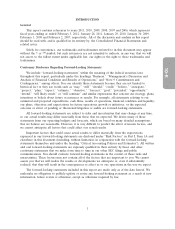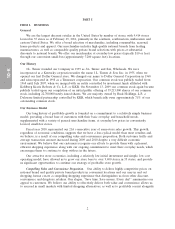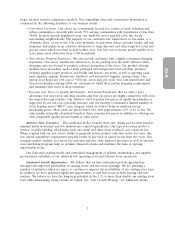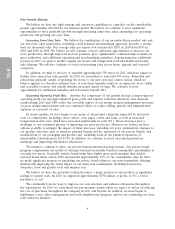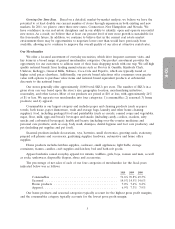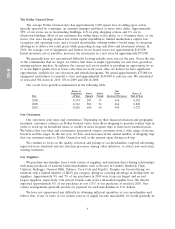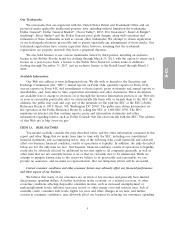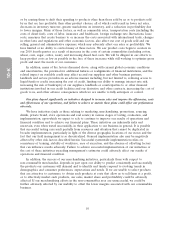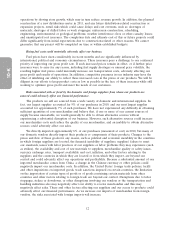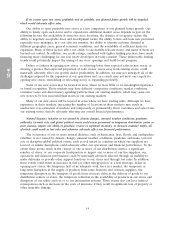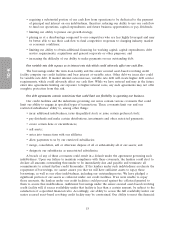Dollar General 2010 Annual Report Download - page 88
Download and view the complete annual report
Please find page 88 of the 2010 Dollar General annual report below. You can navigate through the pages in the report by either clicking on the pages listed below, or by using the keyword search tool below to find specific information within the annual report.
10-K
or by causing them to shift their spending to products other than those sold by us or to products sold
by us that are less profitable than other product choices, all of which could result in lower net sales,
decreases in inventory turnover, greater markdowns on inventory, and a reduction in profitability due
to lower margins. Many of those factors, as well as commodity rates, transportation costs (including the
costs of diesel fuel), costs of labor, insurance and healthcare, foreign exchange rate fluctuations, lease
costs, measures that create barriers to or increase the costs associated with international trade, changes
in other laws and regulations and other economic factors, also affect our cost of goods sold and our
selling, general and administrative expenses, which may adversely affect our sales or profitability. We
have limited or no ability to control many of these factors. We saw product costs begin to escalate in
our 2010 fourth quarter as a result of increases in the costs of certain commodities (including cotton,
wheat, corn, sugar, coffee, resin), and increasing diesel fuel costs. We will be diligent in our efforts to
keep product costs as low as possible in the face of these increases while still working to optimize gross
profit and meet the needs of our customers.
In addition, many of the factors discussed above, along with current global economic conditions
and uncertainties, the potential for additional failures or realignments of financial institutions, and the
related impact on available credit may affect us and our suppliers and other business partners,
landlords and service providers in an adverse manner including, but not limited to, reducing access to
liquid funds or credit, increasing the cost of credit, limiting our ability to manage interest rate risk,
increasing the risk of bankruptcy of our suppliers, landlords or counterparties to or other financial
institutions involved in our credit facilities and our derivative and other contracts, increasing the cost of
goods to us, and other adverse consequences which we are unable to fully anticipate or control.
Our plans depend significantly on initiatives designed to increase sales and improve the efficiencies, costs
and effectiveness of our operations, and failure to achieve or sustain these plans could affect our performance
adversely.
We have initiatives (such as those relating to marketing, merchandising, promotions, sourcing,
shrink, private brand, store operations and real estate) in various stages of testing, evaluation, and
implementation, upon which we expect to rely to continue to improve our results of operations and
financial condition and to achieve our financial plans. These initiatives are inherently risky and
uncertain, even when tested successfully, in their application to our business in general. It is possible
that successful testing can result partially from resources and attention that cannot be duplicated in
broader implementation, particularly in light of the diverse geographic locations of our stores and the
fact that our field management is so decentralized. General implementation also may be negatively
affected by other risk factors described herein. Successful systemwide implementation relies on
consistency of training, stability of workforce, ease of execution, and the absence of offsetting factors
that can influence results adversely. Failure to achieve successful implementation of our initiatives or
the cost of these initiatives exceeding management’s estimates could adversely affect our results of
operations and financial condition.
In addition, the success of our merchandising initiatives, particularly those with respect to
non-consumable merchandise, depends in part upon our ability to predict consistently and successfully
the products our customers will demand and to identify and timely respond to evolving trends in
demographics and consumer preferences, expectations and needs. If we are unable to select products
that are attractive to customers, to obtain such products at costs that allow us to sell them at a profit,
or to effectively market such products, our sales, market share and profitability could be adversely
affected. If our merchandising efforts in the non-consumables area are unsuccessful, we could be
further adversely affected by our inability to offset the lower margins associated with our consumables
business.
10



